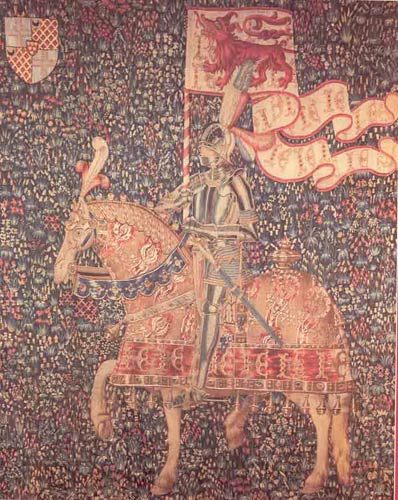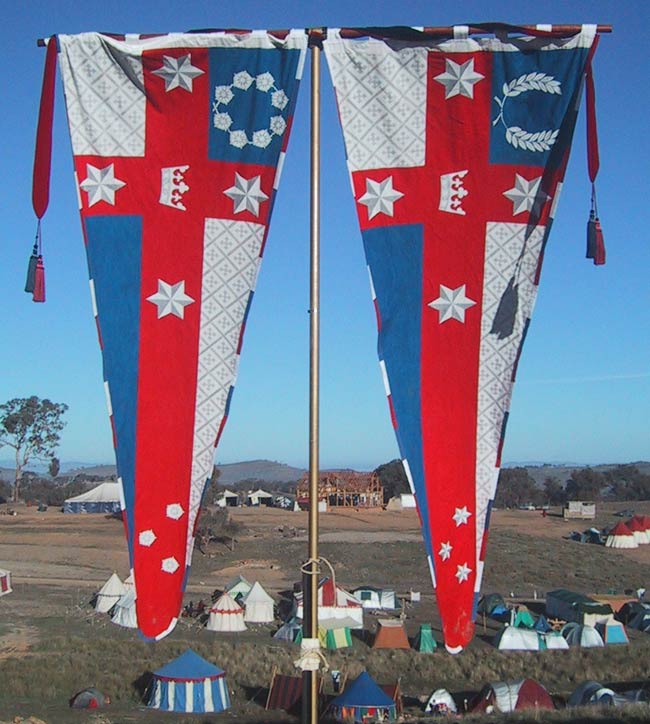Heraldic Standards
Period examples of heraldic standards are found represented across nearly every art form of the medieval period. They appear on many famous tapestries, on rolls of arms, on embroiders, in patent of arms documents, funereal certificates and are very frequently depicted in illuminated miniatures.

Jean de Dillion Tapestry - c1481
In order to create a ceremonial atmosphere at baronial and kingdom court events, we have fashioned personal standards bearing the St Florian Bottony Cross and our individual devices. This has allowed our group to make impressive and cohesive displays when decorating halls or tourney fields. Everyone in our Barony is encouraged to display their devices on a standard, even if your device isn’t registered - yet!
It is unusual, if not rare, for a standard to display an exact representation of an individual’s heraldic arms. More often than not, examples show a design based on the charges and colours that appear in the original design, which means, if you know what colours you are determined to have, and you have decided on your charges, you can design your standard - even if your device submission is bogged down in the quagmire that is the College of Heralds.
For example, this is Lady Salaberge de Granson’s device, which wasn’t registered until months after the standard on the right was completed.


As mentioned above, examples of standard designs are commonly seen in manuscripts, patents and funereal certificates. Note the motto bands depicted in these examples, as well as the good use of space and repetition of charges, all of which are typical elements in standard designs.

Funereal Certificate for Joscelyne Family
Paston-Betingfeld & Gwynn-Jones (Pg 48)

Funereal Certificate for Sir John Spencer 1599
Williamson (pg 39)
Painted Banners

Extant banner for the City of Ghent circa 1375 tempura on linen
Anecdotal accounts supporting the use of paint on fabric as a period banner and standard making technique are hard to find. I have included these two pictorial exampes, though to date haven’t had great success in gaining information on period methods and materials for painted banners.

We have been using Permaset screen printing inks, which, thus far, have proven to be sufficiently colour fast. Having said that, none of our standards have been submitted to laundering or been out in deliberately in heavy rain. There are other (cheaper) fabric paints available, but we have found the Permaset ink is easy to use, mixes well, and gives good coverage. Permaset inks ‘set’ well and become waterproof if after being heat treated (ie: ironed). To heat treat our larger banners, we usually lay them out on hot concrete for a day or so, which is a lot easier than trying to iron every inch for a few minutes!

Douglas of Cavers Ceremonial Standard
Believed to have been carried by Archibald Douglas of Cavers at the Battle of Ottrburn 1388
Painted silk H:1.2m x L: 4m (National Museum of Scotland)
Banner Design
When designing your standard, look for inspiration from period examples. These can be found in illuminations depicting camps and battle scenes etc; patent of arms and roll of arms documents; funereal certificates; needlework and tapestry designs.

Battle of Najera c1367 Edward Black Prince and Enrique II of Castille
Size and shape: It is important to get the size and shape of your standard correct. This means paying particular attention to the size, angle, and section divisions. The standard size we have used on the St Florian standards (sorry!) is 2.7m in finished length, and 1.05m in width. The hoist section is exactly 75 cm wide. Using the same measurements will ensure your standards appear, well… standard! **Please note - the Kingdom of Lochac has no sumptuary laws, this means that you can make your standards or gonfalons any size you like, we have chosen to make our standards to a uniform size so they have a greater visual impact when displayed en masse. Parts of the Banner: The section closest to the pole, is called the chief or the hoist, where you might put your Baronial affiliation, for cohesion. This concept was derived the practice of English nobles to display the arms of St George in the hoist part of their standard. Use cardboard templates to keep your devices uniform in size, and placement.

St Florian Standard
Here are a few design elements that are commonly seen in period depictions of standards.
- Colour: applying the normal rules of heraldic contrast will ensure the colours on your standard are easily distinguishable and visually striking even at distance. No metals on metals, no colours on colours.
- Repetition: charges are often represented repeated down the fly of the standard, graduating in sizes. Usually seen in threes, and often interspersed with motto bands. A useful way of incorporating secondary charges is to show them strewn on the field (semy).
- Secondary Charges: these would include charges from your own heraldry, or you may wish to incorporate household badges, personal badges or symbols of rank.
- Diapering: this technique is used to overcome what is often called ’le horror vacui’ which is basically an abhorrence of empty space in the design. If you are planning on using diapering, you will need to research an appropriate pattern for your time frame and culture. For an example - have a look at the argent/white sections of our St Florian Kingdom Standards, they are subtly diapered with a buttony cross pattern.
- Mottos: optional design element, usually incorporated into the design in one of two ways. On motto bands which break the standard design into segments, or in the body of the design on the fly of the standard.
Techniques
Designing Hints:
- Bold, simple designs are most effective and recognizable from a distance.
- Base your design around your chosen colours and charges rather than the complete device; especially if your device isn’t registered yet.
- Utilizing the primary colours from your deice and the background/field for your design enables the standard to be easily identifiable as your heraldry.
- Enlarging your charges from original drawings using photocopiers, overhead projectors or data projects makes keeping scale of your objects easy, even if you’re not an accomplished artist.
- For charges, objects or patterns that are going to be repeated (such as ermines, sparks, mullets, crosses etc) make templates of cardboard or plastic sheet and always keep your templates for future use.
- Alternately, consider stenciling repeated or strewn charges and devices as this can save considerable time compared to painting each individual charge.
- Don’t try too hard for perfection when measuring up your design; aim for visual symmetry as you don’t want your hand made banner looking printed or machine made
- Try not to get too bogged down in detail; it looks fabulous close up but often the most intricately painted detail is completely lost on the viewer when the banner is flying in the wind or hanging in a candlelit hall.
- Decorating banners, standards and pavilions are the most acceptable time to apply the Ten Foot Rule; if it looks food from 10 feet away then that is good enough.
Painting Hints:
- Add a tiny bit of water to your paint to give it a better consistency, be careful not to water it down. eg - use only a tablespoon of water to a bowl full of paint.
- Avoid loading your brush up with too much paint when doing edges of subjects, or any detailed areas as this can cause dark edging when dry.
- Try to edge up to lines rather than paint along them, you will have more brush control this way and get crisper lines.
- Once started on a section of a singular colour, don’t stop and start which may allow the edge of the painted section to dry as this can cause unsightly ‘watermarks’. Give yourself ample time to do large background areas without stopping.
- Start with darker areas of your design - it is easier to disguise a smudge or mistake on a completed dark patch than to try to hide a dark mark on a finished white section.
- Simplify the detail on the back of your banner - it will only rarely be seen from this side.
- Cover unused paint with cling wrap if you are going to leave it overnight - this will stop it from drying out on you
- Don’t put left over paint back into tubs - it can mysteriously turn your paint ‘off’ or even mouldy (probably due to bacteria introduced in the water).
- Good heraldic colours in Permaset are:
- Sable - Jet Black
- Gules - Bright Red
- Purpure - Purple
- Vert - Mid Green
- Azure - Blue B
- Or - Yellow R or Gold Lustre
- Argent - Standard White or Bright Silver
Materials
Fabric:
- Plain white cotton - slubby looking if possible (drill is okay)
- 3.0m at 110 cm wide will make one
- 5.0m at 150cm wide can make two (and may prove more economical)
Paint:
- Permaset fabric paints, available in Brisbane from Oxlades, Eckersleys, the Art Shed etc
- Bulk 1 litre tubs is more economical, sharing colours will work out cheaper
- Metallic colours tend to be more expensive so consider using them sparingly
Binding:
- Bias binding tape - Spotlight or Lincraft, loads of colours and widths available
- 2 or 3 colour binding - one metre of poplin of each desire colour
- Access to a cutting mat, quilting ruler and roller cutter
Miscellaneous:
- Brushes ranging from 2cm wide down to 0, 00 and 000 brushes for detail :)
- 1m steel ruler, protractor, compass, dividers etc
- Lead pencils and eraser
- A photocopy of your device on overhead transparency
- Cling wrap
- Old bowls/plates and spoons for handling paint
- Kingdom Standards Displayed outdoors in a Royal Encampment at Rowany Festival
 Standards for the Kingdom of Lochac, and the Baron and Baroness of St Florian de la Riviere
Standards for the Kingdom of Lochac, and the Baron and Baroness of St Florian de la Riviere
on display indoors behind a high table at a feast
Made by Sabine du Bourbonnais
 Kingdom standards displayed outdoors in a Royal Encampment at Rowany Festival
Kingdom standards displayed outdoors in a Royal Encampment at Rowany Festival
Select Biography
- Neubecker, Ottfried - Heraldry - Sources, Symbols and Meanings
Tiger Books International, Twickenham, 1997
ISBN 1855019086 - Paston-Betingfeld & Gwynn-Jones; Heraldry. PRC Publishing Ltd, London 1993
- Williamson, David; Debrett’s Guide to Heraldry and Regalia. Headline Book Publishing, London 1992
- Woodcock & Robinson - The Oxford guide to Heraldry
Oxford University Press, London, 2001
ISBN 0192802267
- Woodcock & Robinson - The Oxford guide to Heraldry
